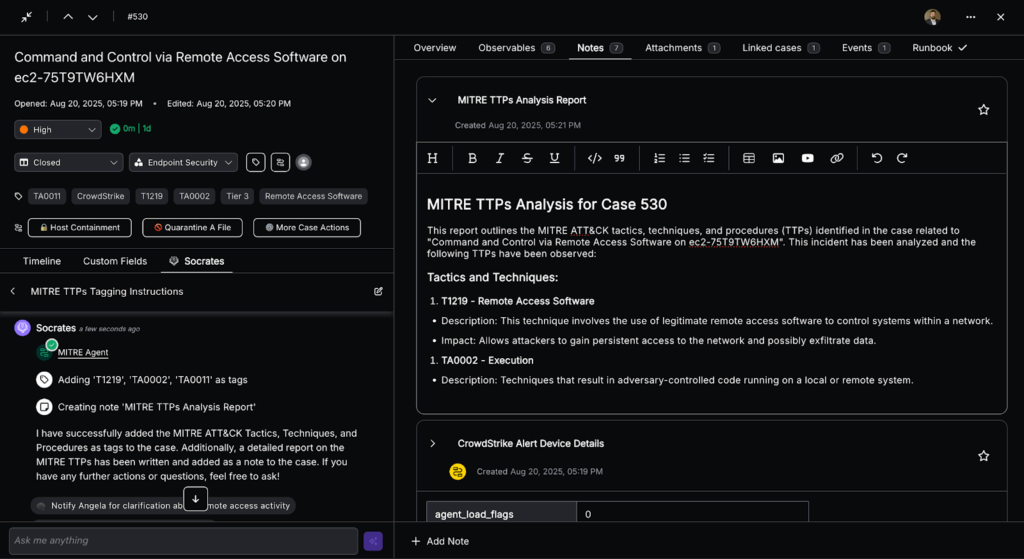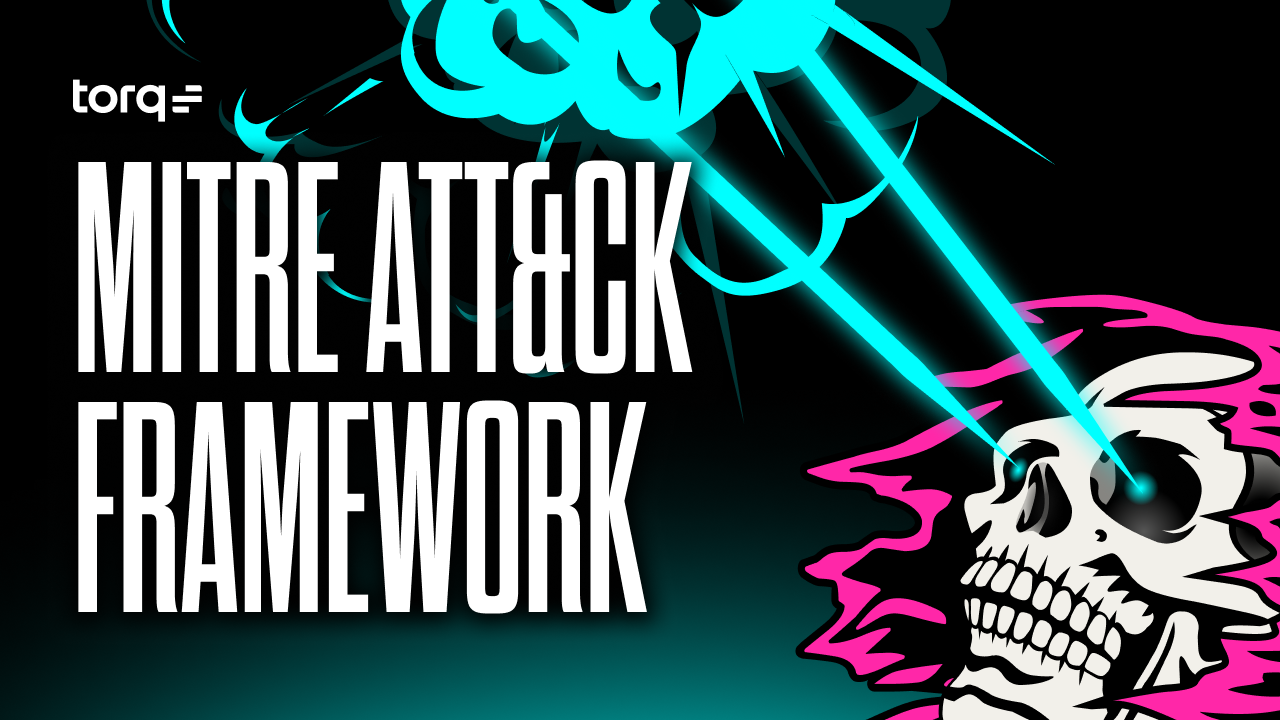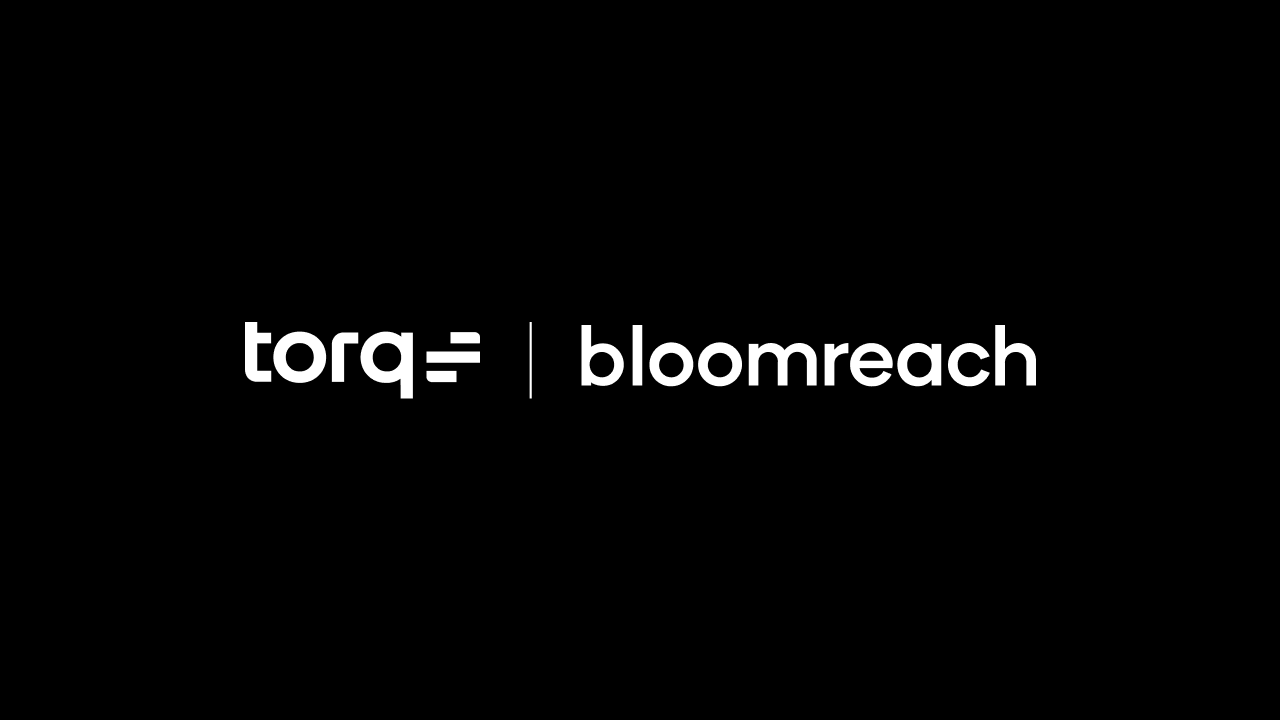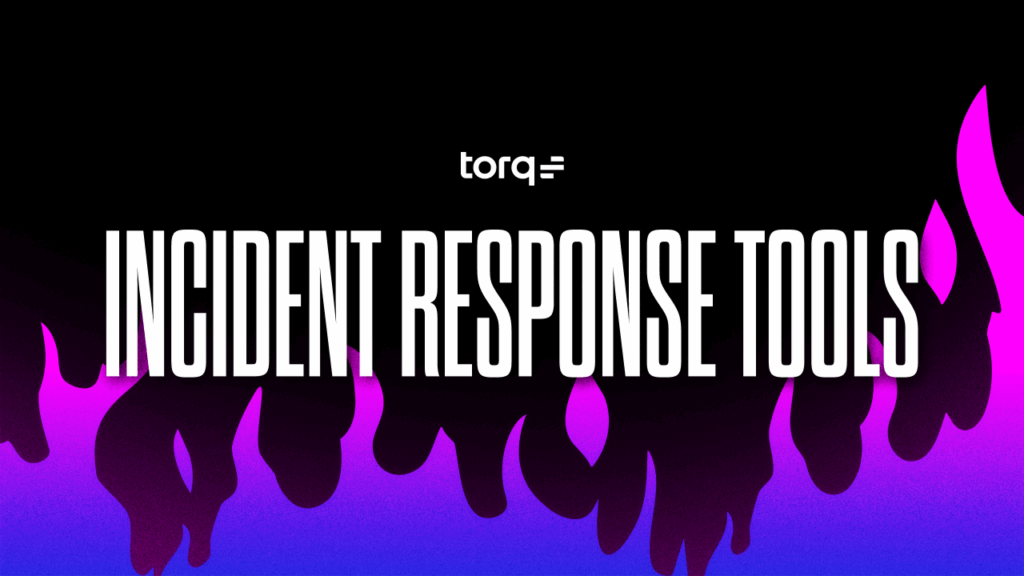Contents
Get a Personalized Demo
See how Torq harnesses AI in your SOC to detect, prioritize, and respond to threats faster.
MITRE ATT&CK has become the de facto SOC framework for classifying adversary behavior — and for good reason. It gives SOC teams a common language to describe threats, uncover gaps, and fine-tune detection logic. But let’s be honest: mapping real-world activity to ATT&CK tactics and techniques is still a time-consuming grind.
For analysts, this usually means bouncing between logs, enrichment sources, and documentation, trying to match cryptic telemetry to the right tactics, techniques, and procedures (TTPs). It’s slow, inconsistent, and vulnerable to human error. In high-volume environments, it just doesn’t scale.
MITRE ATT&CK has become a program in itself. But to use it daily across threat hunting, education, or red/blue teaming, you need automation. Torq Socrates, our agentic AI for autonomous investigation and triage, doesn’t just assist analysts. It acts on their behalf, analyzing cases in real time and automatically mapping findings to the MITRE ATT&CK framework with full context.
Manual MITRE ATT&CK Mapping
Here’s what traditional triage often looks like:
- You receive an alert, maybe an endpoint flagged a suspicious PowerShell command.
- You parse the logs, pull related observables, and try to reconstruct what happened.
- You cross-reference those behaviors with MITRE’s matrix to find matching techniques.
- You paste your findings into the case record, update the timeline, escalate if needed.
Even if you know the MITRE ATT&CK Framework like the back of your hand, this takes time, 30 to 60 minutes or more per case. That adds up fast. And worse, every analyst does it a little differently, leading to inconsistent documentation and uneven detection tuning downstream.
How Socrates Automates MITRE ATT&CK Analysis
The real challenge with MITRE ATT&CK isn’t understanding it — it’s operationalizing it at scale. SOC teams need to move from enrichment to action, and the only way to do that consistently is through automation.
That’s exactly what Torq Socrates delivers. By ingesting alert telemetry, mapping to tactics and techniques, and automating workflows, Socrates bridges the gap between ATT&CK theory and real-world impact, turning what was once a manual grind into a 30-second process. Users can extend or create their own MITRE-aligned workflows in minutes using Torq’s no-code/low-code environment.
Here’s how Socrates applies the MITRE ATT&CK framework in every case it touches:
- Ingests case data: Socrates automatically parses alerts, logs, user inputs, and contextual artifacts from across your integrated toolchain.
- Identifies patterns across incidents: Socrates compares TTP fingerprints over time, helping teams correlate seemingly unrelated cases or surface persistent attacker behaviors.
- Summarizes behaviors: Using natural language processing (NLP), it identifies key actions and patterns (e.g., command execution, credential access, lateral movement).
- Maps to ATT&CK: Socrates aligns those behaviors to tactics and techniques from the MITRE ATT&CK framework.
- Annotates the case: It logs its reasoning, links evidence, and updates the timeline with MITRE-aligned insights.
- Takes action: Based on policy, Socrates escalates, auto-remediates, or closes the case.

Torq Workflow: Create MITRE ATT&CK Layer from TTP List
Socrates makes it easy to map TTPs to MITRE ATT&CK in every case automatically. But what if you want to go one step further, turning that mapping into a visual layer for deeper analysis or reporting?
This workflow takes any list of TTPs, whether generated by Socrates, entered manually, or ingested from another system, and automatically builds a shareable ATT&CK layer in both JSON and SVG formats. It’s especially useful for purple team exercises, threat hunting retrospectives, or briefing stakeholders with a visual snapshot of attack coverage.
Here’s what the workflow does:
- Ingests a list of Tactics and Techniques from the triggering case.
- Enriches input by expanding Tactics into associated Techniques using MITRE’s dataset (if Techniques aren’t provided directly).
- Builds a unique list of all Techniques and Sub-techniques.
- Generates two output formats: a JSON file for MITRE ATT&CK Navigator, and an SVG image for visualization.
- Attaches the outputs directly to the case timeline for easy access and sharing.
The result is a fast, fully automated way to move from raw TTPs to a structured, visual MITRE layer. Just plug this workflow into any investigation where visual context helps drive decisions, and let Torq handle the rest.
Socrates vs. Manual Triage: A Side-by-Side Look
Consider a privilege escalation case triggered by suspicious endpoint behavior. A manual investigation typically takes 30-60 minutes, including log parsing, tactic identification, and evidence documentation.
With Socrates, the entire process is completed in approximately 30 seconds:
- Detected behavior: Suspicious PowerShell execution via endpoint telemetry.
- MITRE ATT&CK technique identified: T1059 – Command and Scripting Interpreter.
- Evidence collected: PowerShell command logs with encoded payload execution, network activity to known malicious IPs.
- Automated response recommendation: Endpoint isolation via integrated EDR, notification sent to IAM team for compromised credentials.
- Outcome: Accelerated incident response, standardized classification, clear audit trails, and significantly reduced analyst workload.
Manual Approach:
- Parse endpoint telemetry
- Decode command strings
- Match to MITRE techniques
- Draft summary and tag case
- Escalate and notify IR team
- Time spent: ~45 minutes
Socrates Approach:
- Auto-ingests alert + context
- Detects suspicious use of net localgroup administrators
- Maps to T1069.002 – Permission Groups Discovery: Domain Groups
- Updates case, isolates host, triggers IAM sync
- Time spent: ~30 seconds
Benefits of Automated MITRE ATT&CK Mapping
When Socrates handles MITRE mapping:
- Threat classification is consistent across cases, shifts, and teams
- Detection tuning improves because you’re measuring coverage by tactic and technique
- Cross-case correlation gets easier, especially for threat hunting recurring attacker behavior
- Audit and reporting get simpler with standardized documentation
- Purple teaming and validation are enhanced by visual, real-time ATT&CK layer generation
- Behavioral pattern recognition strengthens your defense posture, as Socrates identifies recurring techniques and stealthy attack strategies across historical cases, supporting more proactive threat hunting and detection refinement.
- Visual MITRE ATT&CK heatmaps provide strategic insight, showing which techniques are detected, underutilized, or missed entirely. These insights directly support:
- Purple team planning and retrospective analysis
- Stakeholder and executive briefings
- SOC maturity assessments and coverage evaluations
- Detection engineering prioritization
SOCs that rely on MITRE but analyze it manually leave speed and quality on the table. Socrates gives you full fidelity, with none of the manual effort.

Beyond MITRE ATT&CK: Expanding the Impact of Socrates
Torq Socrates extends its automation beyond MITRE ATT&CK, providing:
Real-time threat enrichment: Socrates enriches every case with live intelligence from integrated sources like VirusTotal, WHOIS, and threat intel feeds, automatically attaching file reputation, IP context, domain history, and known indicators. Analysts gain instant clarity without needing to pivot across tools.
Auto-generated case summaries: Using natural language processing, Socrates produces concise, human-readable case summaries that distill the who, what, and how of each incident, accelerating analyst understanding and review. It’s like having a built-in security note-taker.
Policy-driven remediation: Whether isolating a compromised endpoint, resetting credentials, or disabling user access, Socrates follows automated remediation workflows tailored to your policies. Responses are swift, consistent, and fully auditable.
Seamless analyst handoff: Each case maintains complete context, timeline, and linked evidence, making it easy to escalate or reassign without losing momentum. Transitions between analysts — or even shifts — are frictionless and informed.
Comparing Traditional vs. Torq-Powered MITRE ATT&CK Operations
| Capability | MITRE-Agnostic Approach | Torq-Enabled Implementation |
|---|---|---|
| Tagging Alerts & Cases | AI or rule-based tagging of detected activity | Torq HyperSOC auto-tags cases with relevant tactics, techniques and sub-techniques based on telemetry and case artifacts |
| Playbooks / Response | ATT-aligned automation workflows | Templates and playbooks auto-map TTPs, run responses, and visualize ATT layers in JSON/SVG |
| Continuous Validation | Ongoing technique simulation or control tests | Torq continuously processes detection signals in real-time, enforcing ATT‑aligned workflows per incident |
| Case Enrichment | Contextual enrichment of alert data | HyperSOC enriches cases with intel, process metadata, threat info, and correlates to prior incidents with same TTPs |
| Coverage Mapping | ATT matrix dashboards | Visual heatmaps showing TTP coverage across cloud and network based on past case tagging and incident mapping |
| AI / LLM-Powered Automation | NLP for enrichment and tagging | Torq’s LLM engine ingests guidance and framework documentation to enhance accuracy in triage, tagging, and team notifications |
| Customization | Scripted solutions | No-code/low-code builder to create custom ATT&CK workflows |
Operationalize MITRE ATT&CK at Scale with Torq Socrates
MITRE ATT&CK mapping has long been a necessary but burdensome part of security operations. Torq Socrates changes that by fully automating the process, from parsing telemetry and identifying techniques to enriching cases, generating visual layers, and triggering policy-driven responses. It transforms MITRE from a static reference into a dynamic, real-time engine for smarter, faster, and more consistent security.
With Socrates, SOC teams no longer waste time on repetitive analysis or inconsistent tagging. They gain precision, speed, and visibility at scale, allowing them to focus on proactive defense, strategic initiatives, and continuous improvement.
MITRE ATT&CK doesn’t have to be a manual grind. With Torq Socrates, it becomes your SOC’s most powerful automation ally.







